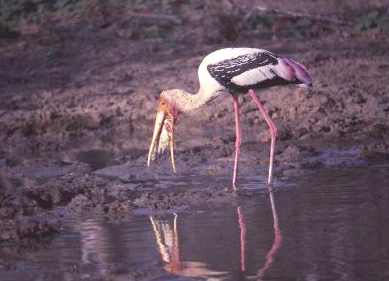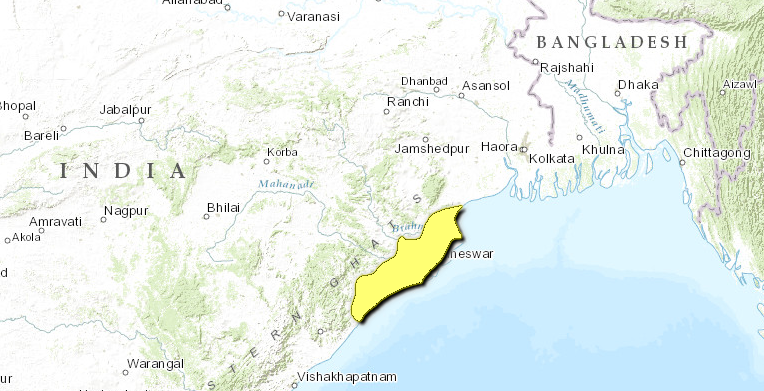Orissa semi-evergreen forests
Introduction The Orissa Semi-Evergreen Rain Forests are neither exceptionally species-rich (Orissa semi-evergreen forests) nor high in endemism. But this ecoregion does harbor several of the Indian Subcontinent bioregion's charismatic large vertebrates. Some of these include the tiger (Panthera tigris), which is the region's largest predator, and the Asian elephant (Elephas maximus), large herds of gaur (Bos gaurus), and one of the most dangerous mammals in the region, the sloth bear (Melursus ursinus).
Location and General Description
The ecoregion's position on the low hills in the northeastern Indian state of Orissa makes it vulnerable to the full force of the southwestern monsoon winds that sweep in from the Bay of Bengal. The rainfall from this monsoon and the ameliorating year-round oceanic influences create moister climatic conditions here than in the rest of the Deccan Peninsula. Therefore, the ecoregion represents the original extent of distinctly moister semi-evergreen forests that once existed to the east of the Eastern Ghats Mountains.
The ecoregion has an ancient geological lineage of Gondwanaland origins. Therefore, it still harbors relicts of an ancient biota.
Within the predominant semi-evergreen forests of this ecoregion are patches of several other habitat types, such as canebrakes, wet bamboo brakes, moist bamboo brakes, lateritic semi-evergreen forests, and secondary moist bamboo breaks. But most of these habitat types may not be identifiable in the field because of excessive deforestation and changes in land-use practices. Gaussen et al. report the following five series of natural vegetation from this ecoregion: Shorea-Buchanania-Cleistanthus, Shorea-Cleistanthus-Croton, Shorea-Terminalia-Adina, Shorea-Syzygium operculatum-Toona, and Shorea-Dillenia-Pterospermum.
The typical floral community of these forests includes Artocarpus lakoocha, Michelia champaca, Celtis tetrandra, Bridelia tomentosa, B. verrucosa, Dillenia pentagyna, Saraca indica, Ficus spp., Mangifera indica, and Firmiana colorata in the upper story. The second story is characterized by Aphanamixis polystachya, Mesua ferrea, Phoebe lanceolata, Polyalthia spp., Macaranga peltata, Glochidion spp., and Litsea nitida. An understory of evergreen shrubs, canes, and herbs is also present. In the hilly areas with lateritic soils (the residual product of rock decay), the vegetation is characterized by Xylia xylocarpa, Pterocarpus marsupium, Anogeissus latifolia, Grewia tiliaefolia, Terminalia tomentosa, and Terminalia bellirica.
Biodiversity Features
The ecoregion harbors fifty-nine mammal species (Biodiversity). Although none are endemic to the ecoregion, several threatened species warrant conservation attention: the tiger, Asian elephant, gaur, wild dog (Cuon alpinus), sloth bear, and chousingha (Tetracerus quadricornis). The forests of this ecoregion-especially along the higher elevations-may provide dispersal habitat for tigers and leopards from Simlipal in the north to Andhra Pradesh to the south of Orissa.
Bird richness is higher, with more than 215 species, although none are endemic to the ecoregion. The ecoregion harbors a globally threatened species, the lesser florican (Eupodotis indica). Other birds that warrant conservation attention include the Oriental darter (Anhinga melanogaster), greater flamingo (Phoenicopterus ruber), and white-bellied sea eagle (Haliaeetus leucogaster).
Current Status
More than 95 percent of this ecoregion's habitat has been cleared. The remaining forest consists of scattered fragments of Xylia xylocarpa, Pterocarpus marsupium, Anogeissus latifolia, Grewia tiliaefolia, Terminalia tomentosa, and Terminalia bellirica. Even thirty years ago, Champion and Seth alluded to the sub-climax forests throughout most of the ecoregion when they said that "the undisturbed climatic climax no longer exists and we can only surmise that the rapid invasion of the damp deciduous forests and coastal sal by evergreen species after successful fire protection will lead to a climax . . . included as tropical fully evergreen forests."
There are three protected areas that cover 1,102 square kilometers (km2) (5 percent) of the ecoregion, but with the exception of the proposed 970-km2 Chilka reserve, the other protected areas are small, at less than 100 km2 (Table 1)
|
Table 1. WCMC (1997) Protected Areas That Overlap with the Ecoregion. | ||
|
Protected Area |
Area (km2) |
IUCN Category |
|
Nandankanan |
50 |
UA |
|
Chilka |
980 |
PRO |
|
Balukhand Konark |
70 |
IV |
|
Total |
1,100 |
|
Types and Severity of Threats
Cultivation, settlements, and grazing pressure from domestic livestock are the primary threats to the small areas of remaining habitat in the ecoregion.
Justification of Ecoregion Delineation
In an earlier analysis of biogeography and conservation gaps of India, Rodgers and Panwar divided the Gangetic plains into the upper and lower Gangetic plains biotic provinces. In a subsequent regional revision of conservation units, MacKinnon included most of Bangladesh in the lower Gangetic plain biounit. However, MacKinnon also included the patch of coastal semi-evergreen rain forest along the eastern side of the Eastern Ghats with the moist deciduous forests along the Gangetic plains. But in keeping with our rules for defining distinct habitat types of regional extent as separate [[ecoregion]s], we extracted these semi-evergreen forests that are distinct from the surrounding moist deciduous forests into the Orissa Semi-Evergreen Rain Forests. This ecoregion lies within Udvardy's Mahanadian biogeographic province.
Additional information on this ecoregion
- For a shorter summary of this entry, see the WWF WildWorld profile of this ecoregion.
- To see the species that live in this ecoregion, including images and threat levels, see the WWF Wildfinder description of this ecoregion.
- World Wildlife Fund Homepage
| Disclaimer: This article is taken wholly from, or contains information that was originally published by, the World Wildlife Fund. Topic editors and authors for the Encyclopedia of Earth may have edited its content or added new information. The use of information from the World Wildlife Fund should not be construed as support for or endorsement by that organization for any new information added by EoE personnel, or for any editing of the original content. |

